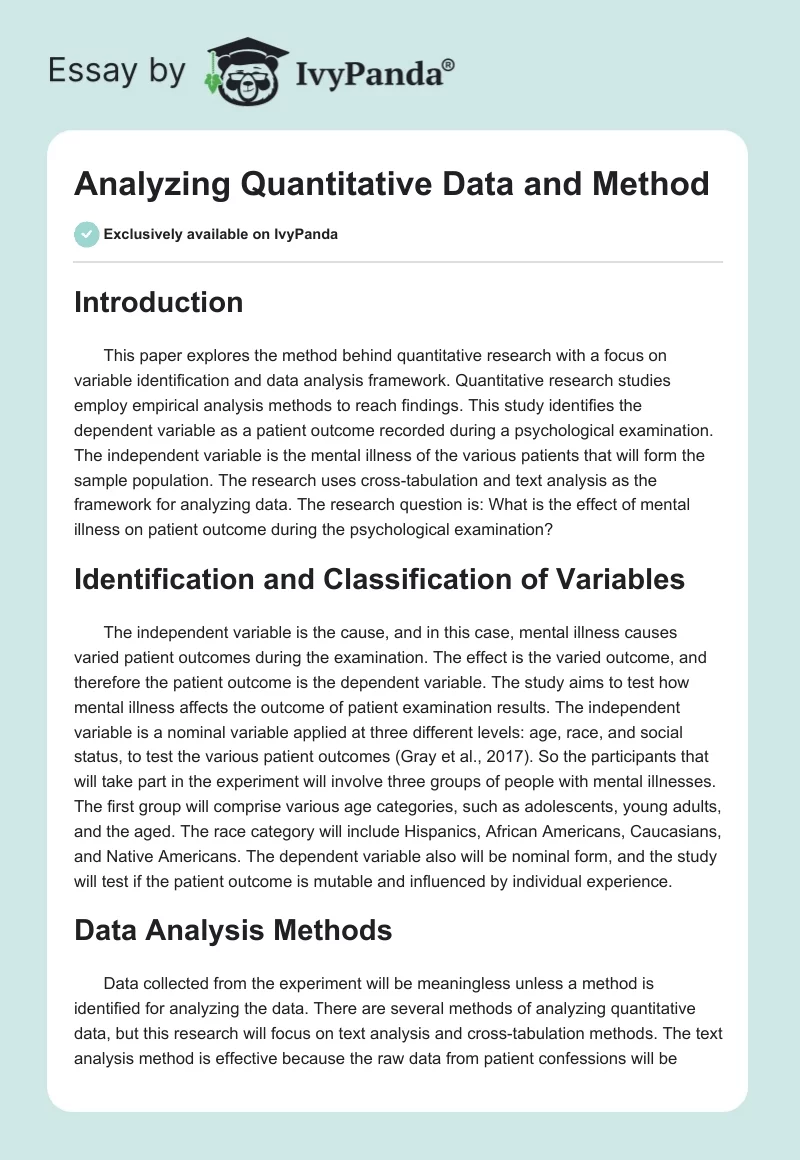Introduction
This paper explores the method behind quantitative research with a focus on variable identification and data analysis framework. Quantitative research studies employ empirical analysis methods to reach findings. This study identifies the dependent variable as a patient outcome recorded during a psychological examination. The independent variable is the mental illness of the various patients that will form the sample population. The research uses cross-tabulation and text analysis as the framework for analyzing data. The research question is: What is the effect of mental illness on patient outcome during the psychological examination?
Identification and Classification of Variables
The independent variable is the cause, and in this case, mental illness causes varied patient outcomes during the examination. The effect is the varied outcome, and therefore the patient outcome is the dependent variable. The study aims to test how mental illness affects the outcome of patient examination results. The independent variable is a nominal variable applied at three different levels: age, race, and social status, to test the various patient outcomes (Gray et al., 2017). So the participants that will take part in the experiment will involve three groups of people with mental illnesses. The first group will comprise various age categories, such as adolescents, young adults, and the aged. The race category will include Hispanics, African Americans, Caucasians, and Native Americans. The dependent variable also will be nominal form, and the study will test if the patient outcome is mutable and influenced by individual experience.
Data Analysis Methods
Data collected from the experiment will be meaningless unless a method is identified for analyzing the data. There are several methods of analyzing quantitative data, but this research will focus on text analysis and cross-tabulation methods. The text analysis method is effective because the raw data from patient confessions will be unstructured but must be brought into a structure that makes sense. Furthermore, the data obtained from the sample population may be open-ended and qualitative, so the text analysis tools will quantify such data and make it meaningful for the study.
The cross-tabulation method is a commonly used framework for its simplicity. The technique employs a tabular form to draw inferences between distinct sets of data (Witkov & Zengel, 2019; Polit, 2010). The different variables like age, social status, and race will yield different results that will be easily compared using the table (Allen, 2017). The researchers can specify the axes of the table as being just one variable or formed from several variables. The tabulation classifies the data in a fashion that makes it easy for analysts to identify mutually exclusive connections between data sets. One benefit of using the cross-tabulation analysis method is the ease with which data can be extracted from the table and used to create graphs and charts.
Conclusion
The independent and dependent variables were grouped as nominal because each was outlined in over one parameter. The independent variable was a mental illness with the following parameters: age, social status, and race. The dependent variable was the patient outcome, tested if mutable and influenced by the patent’s individual experience. Two analysis methods have been identified, and they include text analysis and cross-tabulation. The text analysis method is effective because the raw data obtained from patient confession will be unstructured but must be brought into a structure that makes sense. The cross-tabulation analysis method is helpful since data can be extracted from the table and used to create graphs and charts.
References
Allen, M. (2017). The sage encyclopedia of communication research methods. SAGE Publications.
Gray, J., Grove, S. K., & Sutherland, S. (2017). Burns and Grove’s the practice of nursing research: appraisal, synthesis, and generation of evidence. Saunders.
Polit, D. F. (2010). Cram101 textbook outlines to accompany: Data anal. And statistics for nursing research, Denise F. Poli (2nd ed). Cram101 Inc.
Witkov C., & Zengel, K. (2019). Two–parameter chi-squared analysis.Chi-Squared Data Analysis and Model Testing for Beginners, 32–36. Web.


